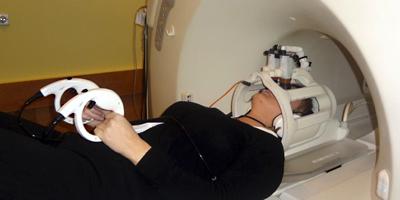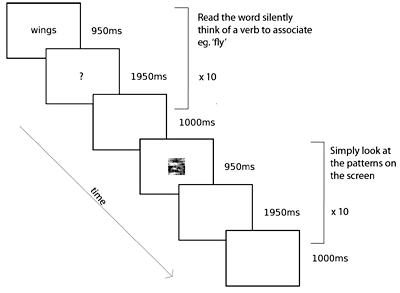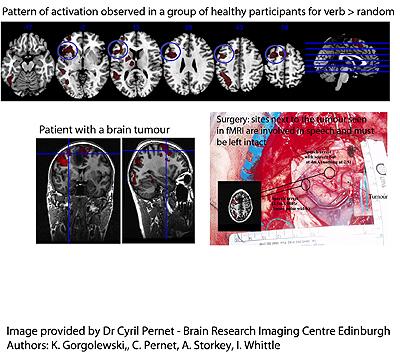Functional MR (fMRI)
Functional MRI (fMRI) is a non-invasive tool for studying brain function, both in healthy volunteers and clinical patients.
Overview
Purpose
Detail
Contact
- Dr Cyril Pernet
Relevant publications
- Stephen L, et al., Multimodal brain imaging in the DISC1 family
- A M McIntosh, et al., The effects of a neuregulin 1 variant on white matter density & integrity, Molecular Psychiatry 2007. doi:10.1038/sj.mp.4002103
- A C Stanfield, et al., Evaluating sex & age differences in ADI-R & ADOS scores in a large european multi-site sample of individuals with autism spectrum disorder, Journal of Autism & Developmental Disorders 2018. doi:10.1007/s10803-0 18-3510-4
- A C Stanfield, et al., The experience & impact of anxiety in autistic adults: A thematic analysis, Research in autism spectrum disorders 2017. doi: 10.1016/j.rasd.2017.11.006
- A C Stanfield, et al., A pilot randomised controlled trial of a group based social skills intervention for adults with autism spectrum disorder, Research in autism spectrum disorders 2017. doi:10.1016/j.rasd.2017.08.001
- A C Stanfield, et al., Dissociation of brain activation in autism & schizotypal personality disorder during social judgements, Schizophrenia Bulletin 2017. doi: 10.1093/schbul/sbx083
- A C Stanfield, et al., The association of autistic traits & behavioural patterns in adolescents receiving special educational assistance, Journal of Autism & Developmental Disorders 2015. doi:10.1007/s10803-015-2445-2
- A C Stanfield, et al., Psychopharmacology in children with intellectual disability & autism - a cross-sectional analysis (2010), International journal of developmental disabilities 2013. doi:10.1179/2047386912Z.00000000016
- A C Stanfield, et al., A systematic review & meta-analysis of the fMRI investigation of autism spectrum disorders, Neuroscience & Biobehavioral Reviews 2012. doi:10.1016/j.neubiorev.2011.10.008
fMRI relies on techniques that detect blood changes in relation to brain activity involved during the execution of various tasks such as moving fingers, looking at images, reading, listening to music, solving problems. It is being used to address a wide variety of research questions concerning for example: memory, language, ageing, brain tumours, pain and psychiatric disorders. fMRI relies mainly on the blood-oxygen-level dependent (BOLD) contrast, although other techniques can be used. When nerve cells are active they consume glucose and oxygen and this consumption leads to a local increase in blood flow. Because (1) there is an hyperperfusion of the local tissue (lots more oxygen is provided than needed) and (2) blood with and without oxygen have different magnetic susceptibility, signal intensity changes on the images can be detected.
Advantages of fMRI
- fMRI non-invasively records brain signals (of humans and other animals) without the risks of radiation inherent in other scanning methods.
- It records on a spatial resolution in the region of 1 to 6 millimetres, higher than any other techniques.
- fMRI has the capacity to demonstrate the entire network of brain areas engaged when subjects undertake particular tasks.
General disadvantages of the method
- The BOLD signal is only an indirect measure of neural activity, and is therefore susceptible to influences of non-neural changes.
- For a non-invasive scan, fMRI has moderately good spatial resolution. However, the temporal response of the blood supply, which is the basis of fMRI, is poor relative to the electrical signals that define neuronal communication. Note that the poor resolution is mainly due to the phenomena being measured, not because of the technique.
Like any other technique, fMRI is as worthwhile as the design of the experiment using it. Many investigators have used fMRI ineffectively because they were not familiar with all aspects of the technique, or because they received their academic training in disciplines where designs were more ‘flexible’ than some other branches of psychology and neuroscience. Ineffective use of the technique is a problem for the field, but it is not a consequence of the technique itself.
Research activities
Psychiatric disorders:
Schizophrenia. In collaboration with Psychiatry, we undertake a number of imaging studies. For example:
Multimodal brain imaging in the DISC1 family
Bipolar Disease. In collaboration with Psychiatry, we undertake a number of imaging studies. For example:
The effects of a neuregulin 1 variant on white matter density and integrity
Epilepsy:
Dr Cyril Pernet, currently working with NHS Lothian looking at fMRI and pre surgical planning.
Alzheimers Disease:
Currently working on Short Term Memory Binding (STMBAD) project with Dr Mario Alfredo Parra from Department of Psychology.
Brain Tumours:
Currently working with NHS Lothian looking at fMRI and pre surgical planning.
Autistic Spectrum Disorder:
Currently working with Dr Andrew Stanfield, from the Department of Psychiatry on projects investigating the autistic spectrum. To view projects click here:
CAT Aphasia:
Currently working with Dr Cyril Pernet, our PhD student Anna Jones, is researching the recovery of auditory comprehension impairments using REACT2 computer-assisted therapy in people with aphasia following stroke.
Pain Studies:
Two studies are currently looking at how the brain processes pain and how this affect differently patients. One study (a clinical trial) led by Prof Andrew Horne, is investigating the effect of gabapentin on pain perception for the treatment of chronic pelvic pain. The second study involves, Dr Peter Foley, investigate pain perception and pathways involved in multiple sclerosis patients suffering from chronic pain.
fMRI in practice:

The above image shows the subject prepared for fMRI with goggles which provide high quality images, audio system with headphones and microphone and the response system which has ergonomic “pistol-style” grips.
At the Brain Research Imaging Centre, we have interest in clinical applications of functional MRI. The figure below illustrates such application. Patients are asked to perform different tasks inside the scanner whilst we acquire images of their brain. In the example below, the patient alternates between reading words and finding verbs associated to them (e.g. wing = fly) and simply looking at visual patterns. After analysing the images, the signal between the 2 conditions is compared and one can observe ‘activations’ in a region of the brain called the Broca area and in the premotror cortex. These regions are essential to anyone to produce speech. Such mapping allow surgeons to decide if surgery is safe or not, and to better plan surgery when active areas are in the vicinity of the tumour to resect.


Example of fMRI paradigm with clinical application (above). This figure shows 2 trials that are then repeated 10 times (using different words). Patients have to generate verbs associated to these words. This task elicits activation in Broca area and the premoror cortex, 2 regions essential for speech. Such mapping allow surgeons to precisely locate these regions in relation to the tumour to be resected (shown bottom right).
Staff contact
If you wish further information on any of the above activities, please contact Dr Cyril Pernet:

